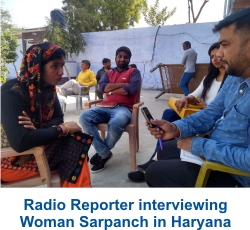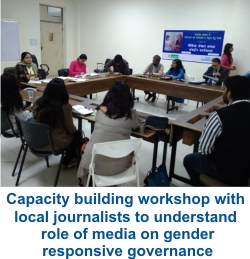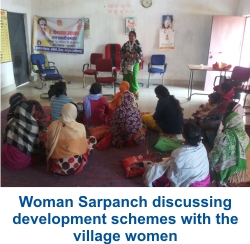|
Media Impacting Role of
Media
is considered to be a potentially powerful channel of information in
Media engagement and advocacy on the issue of women’s participation in politics and governance has been limited. Only to some extent, media has proved to be a strong medium of making women politically empowered and helping to build a sense of who they are and who they aspire to be.
It has been observed that media often
overlooks the values, beliefs and experiences of women candidates and is
sometimes also critical of their participation. Media, which is
considered to be the fourth pillar of democracy a Development Alternatives-C4D Strategy Over the last three decades Development Alternatives has designed and implemented communication strategies on various development issues. Development Alternatives proposes to leverage its experience of engaging with rural communities through community radio in collaboration with UN Women for an initiative to promote ‘women’s participation in leadership and local governance’. Community radio is a critical enabler for empowering women representatives as a strong local media to create discussion spaces that will help identify concerns regarding policies and legislations that impact women in local governance and leadership in rural India.
A body of knowledge gathered through
secondary research will produce a series of articles, case stories and
photo essays on the subject. Besides a strong communication strategy
will be used to engage media at various levels for in It has been observed that media puts feminine characteristics over and above political insight and policy making experience of women, giving their male competitors an edge on them in public discourse. Though the frequency of coverage of women politicians has increased but this increase could be made more meaningful if achieved with the right communication strategies for advocacy.The need of the hour is to build capacities of various media platforms (national, print & online) that can support in positioning this cause at a larger level and also facilitate the process of influencing government and policy makers by upholding the affirmative actions that are guaranteed in the 73rd Constitutional Amendment Act. ■
Mariyam Majeed
Reference
|
 a
society. The messages media transmits can change or reinforce social
customs and behaviours and mobilise citizens
to take progressive actions. While, ideally, media should strive for
accuracy and impartiality, in reality there are often imbalances in
coverage, including how women are portrayed. There tends to be a strong
preoccupation in the media to show women as victims. Media has also for
long stereotyped the image of women as homemakers and limited to private
spheres only.
a
society. The messages media transmits can change or reinforce social
customs and behaviours and mobilise citizens
to take progressive actions. While, ideally, media should strive for
accuracy and impartiality, in reality there are often imbalances in
coverage, including how women are portrayed. There tends to be a strong
preoccupation in the media to show women as victims. Media has also for
long stereotyped the image of women as homemakers and limited to private
spheres only. nd
the best medium for creating awareness in society, needs to play a more
proactive role in this sphere.
nd
the best medium for creating awareness in society, needs to play a more
proactive role in this sphere. creased reportage
that encourage discussions and debates on various
policies, norms and conditionalities that either promote or impede
women’s participation in local governance, consequently informing policy
and decision makers about both impacts of impeding legislations and
potential of change that women in local governance can bring about.
creased reportage
that encourage discussions and debates on various
policies, norms and conditionalities that either promote or impede
women’s participation in local governance, consequently informing policy
and decision makers about both impacts of impeding legislations and
potential of change that women in local governance can bring about.